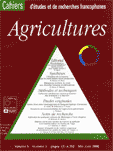Répartition des cercosporioses des bananiers et plantains en Côte d'Ivoire en 1994
Résumé
With losses ranging from 50 to 100%, Sigatoka diseases are among the major limiting factors in banana and plantain production in Côte d'Ivoire. These leaf-spot diseases are caused by two highly destructive fungal species of the genus Mycosphaerella: M. musicola Leach, which causes yellow Sigatoka disease (YSD), and M. fijiensis Morelet, which causes black leaf streak disease (BLSD). Surveys were performed in the major Côte d'Ivoire production areas (Figure) during the 1994 rainy season to determine the influence of host variety, altitude and season on distribution of the two pathogens, and to compare the results with those obtained from similar surveys on Cameroon banana- and plaintain-producing areas. The study was also planned to establish the distribution of the two diseases and control movements of planting material. The two pathogen's areas of prevalence, together or atone, have been recorded. M. fijiensis, the more serious of the two, appeared in the eastern province of Côte d'Ivoire in 1983, close to the border with Ghana, and is still expanding westwards. It damages plantain crops up to the town of Trassale, then coexits with M. musicola to Duekoue, after which only the latter pathogen is found. M. fijiensis is alone to damage banana crops up to the town of Sikensi. BLSD expansion from the southern to the northen province seems slow, and YSD, which occurs alone in the northern part of the country, causes only very slight damage. This is probably due to susceptible hosts being absent over wide areas of the province. Both diseases are virtually absent from the Yamoussoukro and Toumodi areas, which are not important banana- and plantain-producing zones compared to Aboisso, Agboville and Man where disease pressure is very high and strongly correlated to extent of production. M. fijiensis is also absent from high-altitude production areas, especially in the western province. On the other hand, compared to lower regions, plantain seems very susceptible to M. musicola under these high-altitude conditions. The spatial and temporal distribution of the two diseases are influenced by the threefold effect of altitude, host variety and season. Research should enable a better understanding of the two species' spatial distribution, assessment of the various mechanisms of competition between them, and of the potential of M. fijiensis to spread to high-altitude areas.Téléchargements
Publié
1996-05-01
Comment citer
Mouliom Pefoura, A. ., Blizoua-Bi, P., Kobenan, K., & Kone, D. (1996). Répartition des cercosporioses des bananiers et plantains en Côte d’Ivoire en 1994. Cahiers Agricultures, 5(3), 181–184 (1). Consulté à l’adresse https://revues.cirad.fr/index.php/cahiers-agricultures/article/view/29945
Numéro
Rubrique
Articles

